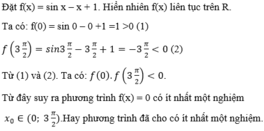Chứng minh rằng phương trình: có ít nhất ba nghiệm
Hãy nhập câu hỏi của bạn vào đây, nếu là tài khoản VIP, bạn sẽ được ưu tiên trả lời.


Đặt f(x) = x5 – 3x4 + 5x – 2
f(x) là hàm đa thức nên liên tục trên R.
Ta có: f(0) = –2 < 0
f(1) = 1 > 0
f(2) = -8 < 0
f(3) = 13 > 0
⇒ f(0).f(1) < 0; f(1).f(2) < 0; f(2).f(3) < 0
⇒ Phương trình f(x) = 0 có ít nhất 1 nghiệm thuộc khoảng (0; 1); 1 nghiệm thuộc khoảng (1; 2); 1 nghiệm thuộc khoảng (2; 3)
⇒ f(x) = 0 có ít nhất 3 nghiệm thuộc (0; 3) hay f(x) = 0 có ít nhất 3 nghiệm thuộc (-2; 5).

* Giả sử cả 3 pt đều có nghiệm kép hoặc vô nghiệm ta có :
pt \(x^2-2ax+b=0\) (1) có \(\Delta_1'=\left(-a\right)^2-b=a^2-b\le0\)
pt \(x^2-2bx+c=0\) (2) có \(\Delta_2'=\left(-b\right)^2-c=b^2-c\le0\)
pt \(x^2-2cx+a=0\) (3) có \(\Delta_3'=\left(-c\right)^2-a=c^2-a\le0\)
\(\Rightarrow\)\(\Delta_1'+\Delta_2'+\Delta_3'=\left(a^2+b^2+c^2\right)-\left(a+b+c\right)\le0\) (*)
Lại có : \(0< a,b,c< 3\)\(\Rightarrow\)\(\hept{\begin{cases}a\left(3-a\right)>0\\b\left(3-b\right)>0\\c\left(3-c\right)>0\end{cases}\Leftrightarrow\hept{\begin{cases}3a>a^2\\3b>b^2\\3c>c^2\end{cases}}}\)
\(\Rightarrow\)\(\left(a^2+b^2+c^2\right)-\left(a+b+c\right)< 3\left(a+b+c\right)-\left(a+b+c\right)=2\left(a+b+c\right)=6>0\)
trái với (*)
Vậy có ít nhất một phương trình có hai nghiệm phân biệt
cái kia chưa bt làm -_-

Chứng minh rằng phương trình sau có ít nhất hai nghiệm :

- Xét hàm số: f ( x ) = 2 x 3 - 5 x 2 + x + 1 là hàm đa thức.
⇒ Hàm số f liên tục trên R.
- Ta có:
 có ít nhất một nghiệm c1 ∈ (0;1).
có ít nhất một nghiệm c1 ∈ (0;1).
 có ít nhất một nghiệm c2 ∈ (2;3).
có ít nhất một nghiệm c2 ∈ (2;3).
- Mà c ≠ c 2 nên PT f(x) = 0 có ít nhất 2 nghiệm.

Đặt \(f\left(x\right)=\left(m^2-m+1\right)x^4-3x^3-1\)
\(f\left(x\right)\) là hàm đa thức nên liên tục trên mọi khoảng trên R
\(f\left(0\right)=-1< 0\)
\(f\left(3\right)=81\left(m^2-m+1\right)-55=81\left(m-\dfrac{1}{2}\right)^2+\dfrac{23}{4}>0\)
\(\Rightarrow f\left(0\right).f\left(3\right)< 0\Rightarrow\) pt có ít nhất 1 nghiệm thuộc \(\left(0;3\right)\)
\(f\left(-1\right)=m^2-m+2=\left(m-\dfrac{1}{2}\right)^2+\dfrac{7}{4}>0\)
\(\Rightarrow f\left(-1\right).f\left(0\right)< 0\Rightarrow\) pt có ít nhất 1 nghiệm thuộc \(\left(-1;0\right)\)
\(\Rightarrow\) Pt có ít nhất 2 nghiệm thuộc \(\left(-1;3\right)\Rightarrow\) có ít nhất 2 nghiệm trên \(\left(-5;5\right)\)

Đặt \(f\left(x\right)=x^5+x^2-\left(m^2+2\right)x-1\Rightarrow f\left(x\right)\) liên tục trên R
Ta có: \(f\left(0\right)=-1< 0\)
\(f\left(-1\right)=m^2+1>0\) ; \(\forall m\)
\(\Rightarrow f\left(0\right).f\left(-1\right)< 0\) ;\(\forall m\)
\(\Rightarrow f\left(x\right)=0\) luôn có ít nhất 1 nghiệm thuộc \(\left(-1;0\right)\) (đpcm)
nếu bài này mà chứng minh có 3 nghiệm thì mình phải làm như thế nào ạ..?

x2+ax+1=0
Δ1=a²−4
x2+bx+1=0
Δ2=b²−4
Do ab≥4 nên có ít nhất 1 trong 2 số aa và b≥2
→ Hoặc Δ1=a²−4≥0
→ Hoặc Δ2=b²≥0

Đặt \(f\left(x\right)=x^5+x^2-\left(m^2+2\right)x-1\)
Hàm \(f\left(x\right)\) liên tục trên R
\(f\left(0\right)=-1< 0\)
\(\lim\limits_{x\rightarrow+\infty}f\left(x\right)=\lim\limits_{x\rightarrow+\infty}\left(x^5+x^2-\left(m^2+2\right)x-1\right)\)
\(=\lim\limits_{x\rightarrow+\infty}x^5\left(1+\dfrac{1}{x^3}-\dfrac{m^2+2}{x^4}-\dfrac{1}{x^5}\right)=+\infty.1=+\infty\)
\(\Rightarrow\) Luôn tồn tại \(a>0\) sao cho \(f\left(a\right)>0\Rightarrow f\left(0\right).f\left(a\right)< 0\Rightarrow\) pt luôn có ít nhất 1 nghiệm thuộc \(\left(0;+\infty\right)\)
\(f\left(-1\right)=m^2+1>0;\forall m\Rightarrow f\left(-1\right).f\left(0\right)< 0\Rightarrow\) pt luôn có ít nhất 1 nghiệm thuộc \(\left(-1;0\right)\)
\(\lim\limits_{x\rightarrow-\infty}\left(x^5+x^2-\left(m^2+2\right)x-1\right)=\lim\limits_{x\rightarrow-\infty}x^5\left(1+\dfrac{1}{x^3}-\dfrac{m^2+2}{x^4}-\dfrac{1}{x^5}\right)=-\infty.1=-\infty\)
\(\Rightarrow\) Luôn tồn tại \(b< 0\) sao cho \(f\left(b\right)< 0\Rightarrow f\left(b\right).f\left(-1\right)< 0\Rightarrow\) pt luôn có ít nhất 1 nghiệm thuộc \(\left(-\infty;-1\right)\)
Vậy pt đã cho luôn có ít nhất 3 nghiệm thực

Xét hàm số f ( x ) = x 5 − 5 x – 1 trên các đoạn [−2; −1], [−1; 0], [0; 3]